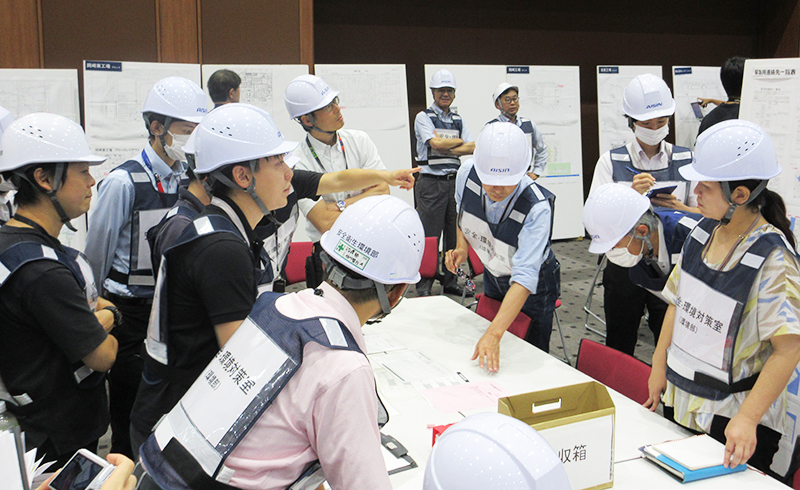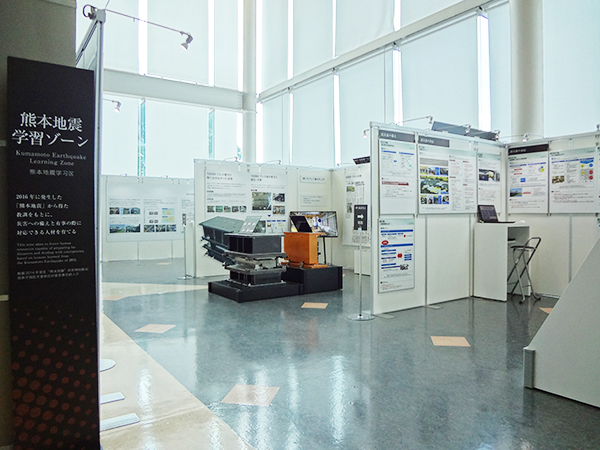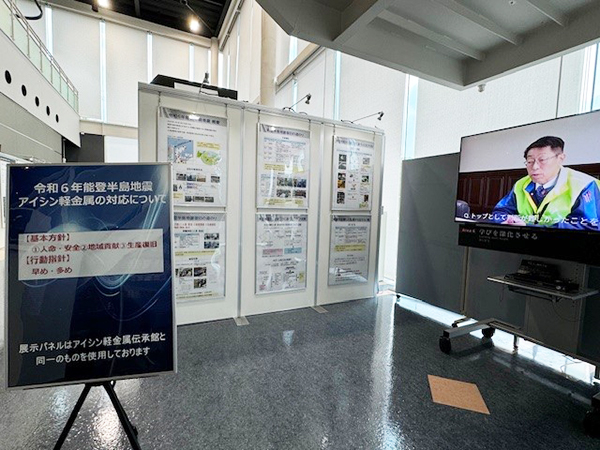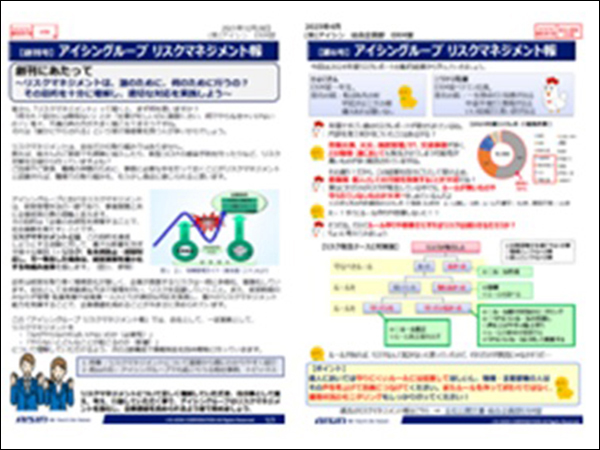Governance
Basic stance and policy
Aisin considers risk management to be one of two wheels that drive corporate management, the other being business activity. As we execute our management strategies, risks impacting our business increasing owing to rapid shifts in the external environment. We address risks that could hinder growth by both identifying and controlling them and by strengthening our business continuity apparatus.
We proactively prevent or mitigate risks that could significantly affect the company effort to achieve its objectives. Should any such risk manifest itself, we will minimize the impact on management and ensure the company's sustainability, thereby meeting the expectations of our stakeholders.
Promotion Structure
Our risk management promotion effort is structured around a Risk Management Committee. This committee consists of the President, CxOs, Audit & Supervisory Board members, and the presidents of the 12 Group companies*1. The committee decides the direction for priority risks requiring attention, based on the status of occurrence within the Company and the environmental conditions and trends inside and outside the Group. This dynamic powers Aisin’s risk countermeasures. For any priority risks identified, the Group Head Office assigns a responsible department to each. We appoint managers to be responsible for countermeasure and staff to promoter risk management at each domestic and overseas Group company. Thus, we strengthen our overall risk response through groupwide efforts.
Furthermore, through regular reporting to the Board of Directors, we ensure oversight of our risk management function and, thereby, enhance our management strategy.
Risk management framework

Twelve Group companies: The 12 Aisin Group companies as of FY2026, excluding the parent were Aisin Takaoka, Aisin Light Metals, Aisin Development, Aisin Kiko, Aisin Sin’ei, Aisin Fukui, Hosei Brake Industry, ADVICS, Aisin Shiroki, Art Metal Industry, Aisin Kyushu, CVTEC
Strategy
Enhancing risk management
We caused inconvenience and concern to many on account of the 1997 Kariya Plant fire. This incident prompted us to introduce ERM*2 to avoid repeating this kind of failure, which has spawned numerous companywide risk management efforts. In recent years, business risk has become increasingly complex and diverse, encompassing natural disasters like major earthquakes and frequent rain squalls, parts supply interruptions, and geopolitical and economic security risks.
Amid these circumstances, we have introduced a risk management process covering risks connected with management strategy and are aiming for sustainable growth and stability. We are proactive about risk management, identifying early signs of risk on the operational side that hinders smooth business operations and on the management strategy front, where it impedes the execution of medium-term management strategies. Once risks are identified, we analyze and evaluate their impact as appropriate.
ERM:Enterprise Risk Management
Key initiatives
Basic initiatives
Based on our risk management process, Aisin works to prevent and mitigate damage during normal operation and, in the event of an emergency, to recover quickly and minimize damage. Furthermore, we maximize our risk management effectiveness by evaluating the performance of these measures, making improvements, standardizing them, and continuously cycling through the risk management process.
Risk management process: PDCA cycle

BCP:Business Continuity Planning
Response under normal conditions
Risk assessment (identifying priority risks)
Aisin enacts risk assessment exercises twice a year. We identify potential risks from the distinct perspective of departments tasked with managing specific risks, the operational characteristics of our Group companies, and the geographies of our locations abroad. Our risk evaluation process simultaneously analyzes assessed results based on the frequency of occurrence, related trends, and impact severity, and also with consideration for the relative suppression and mitigation success or failure of past risk countermeasures.
Furthermore, concurrently with these internal risk evaluations, the Risk Management Committee classifies serious risks as top-priority or priority with reference to external perspectives, such as prioritization by customers, investors, and other stakeholders and risk assessments by specialized institutions, such as global risk reports.
Aisin Group priority risks for FY2026

Risk countermeasures and monitoring
Top-priority risks and priority risks determined by the Risk Management Committee are addressed by various committees and the departments responsible for each class of risk through prevention, mitigation, and controls. The Risk Management Committee monitors top-priority risks, while the ERM Office monitors priority risks as both work toward continuous improvement.
Early warning management
Our management processes implement early warning triggers to help us swiftly detect and avoid risks that could adversely impact our operations. Thresholds for risks are determined, and response procedures (department and action) for when thresholds are exceeded are established in advance.
In an emergency
Emergency response
Our fundamental policy during emergencies prioritizes: (1) human life and safety, (2) community contribution, (3) production recovery. We have established a business continuity plan (BCP) based on this policy, During the initial response to an emergency, a risk report is triggered to promptly notify the President, executives, and departments responsible for relevant risks. This report serves as the catalyst for establishing a disaster response headquarters (levels I to III, commensurate with the crisis level). The head of this headquarters is appointed by the Risk Management Committee chair. The ERM Office, the Risk Management Department, serves as the secretariat for Level I headquarters, while the departments primarily responsible for managing the particular risks serve as the secretariat for Levels II and III.
The response headquarters prioritizes securing human life and safety, aiming to minimize damage.
Next, guided by the notion that Aisin's production recovery in areas impacted by disasters depends on regional restoration, we focus on contributing to the community. Specifically, we collaborate with local governments in affected areas to provide scarce supplies and relief goods and support suppliers in stricken regions with material assistance.
As we resume production, we prioritize restoring critical functions determined in advance based on the extent of damage. In cases where damage is severe, standard operations may shift to alternative tasks or substitute production to ensure business continuity. To prepare for emergencies, each department systematically implements risk control and mitigation measures for specific risks in its sphere or responsibility. Education and training is also conducted in line with our contingency action plans. Particularly for strong earthquakes capable of causing significant damage, the initial response is critical to minimizing damage. Therefore, we regularly conduct disaster response headquarters initial response drills, with senior management directing the response headquarters.
We enhance the effectiveness of our BCP strategy through its design and with training. Under normal circumstances, we simultaneously aim to enhance the crisis-tolerance of our organizations, workplaces, and personnel by preparing our staff for a strong emergency response through these processes.


Education and awareness
We provide education and promote awareness in order to deepen the risk management capabilities of all our employees. We have published a Crisis Management (Risk Management) Guide, which codifies standard operating procedures for risk countermeasures to be implemented under normal conditions (prevention and mitigation) and emergency responses. Moreover, we hold tiered risk management training for each management layer, including our executives, and publish the Aisin Group Risk Management Bulletin for all employees. This document educates and promotes awareness so each employee comes to regard risk as a personal responsibility and ensures countermeasures are thoroughly implemented.
Furthermore, Aisin has established the Kumamoto Earthquake Learning Zone within the Aisin Densho-kan to ensure the devastating damage caused by major earthquakes of the past is never repeated. Through panels and videos, the exhibit shares lessons and insights gained from the damage and recovery efforts following the 2016 Kumamoto Earthquake, ensuring the proper mindset and preparedness for natural disasters. In response to the Noto Peninsula Earthquake of New Year's Day 2024, Aisin is helping to prepare future generations by compiling data on the effectiveness of measures instituted following past disasters and relating to such scenarios as suspended objects and presenting this along with lessons and insights pertaining to newer topics.



Approaches to priority risks and responsible organizations
For initiatives addressing priority risks in FY2026, please refer to the table of priority risks and responsible organizations and the relevant sections of this website.
Note: These risks are regularly reported to the Board of Directors, thereby helping refine our management strategy.
Priority risks and responsible organizations
| Priority risk | Detail explanation | Responsible organization | ||
|---|---|---|---|---|
| Top-priority risk | Management strategy risk | Changes in the market environment | Risk management |
Reviewed at management meetings, strategic function meetings, and executive meetings Promoted by specialized organizations (Corporate Planning Department, Business Strategy Department, Cost Function Management Department/Revenue Planning Department, CN & Environment Promotion Center, Economic Security Office) |
| Economic security | ||||
| Climate change response (CN & CE) | Environment | |||
| Operational risk | Cyberattacks | Information security |
Promoted by specialized organizations (Information Security Department) |
|
| Information leaks | ||||
| Environmental issues | Environment |
Promoted through various committees (Economic Security Committee, Environmental Committee, CN/CE promotion meeting, Quality function meeting, Safety and Health Committee, Human Rights Advisory Committee (subcommittee of the Business Ethics Committee), Regulatory Certification Committee, etc.) |
||
| Quality issues and commercial measures | Quality | |||
| Workplace accidents | Safety and health | |||
| Fires and explosions | ||||
| Human rights issues | Human rights | |||
| Harassment | Compliance | |||
| Human rights | ||||
| Export controls | Risk management | |||
| Part certification violations | Quality | |||
| Major earthquakes | Risk management |
Organized under Risk Management Committee (Disaster Response & Supply Continuity Subcommittee) |
||
| Flooding/snow damage, etc. | ||||
| Production halt (disasters, fires, etc.) | ||||
| Supplier production halt | Supply chain | |||
| Priority risks | Infrastructure supply disruption | Risk management | Handled by departments responsible for specific risks | |
| Logistics disruption | ||||
| Terrorism, political unrest or riots | ||||
| Tornadoes | ||||
| Transaction rationalization | Supply chain | |||
| Antitrust violations | Compliance | |||
| Intellectual property disputes | Intellectual property | |||
| Infectious diseases | Health management | |||
Changes in market environment
To support global business expansion and enhance its corporate value, Aisin is investing in growth areas and businesses in which demand is anticipated to rise. Specifically, we position electrification and the application of artificial intelligence as growth areas and are redeploying resources (people, materials, capital) accordingly and investing strategically, unconstrained by conventional thinking.
With such initiatives, establishing joint ventures, investing in partners, or forming business alliances exposes the Company to risks related to economic security, legal and regulatory compliance, and financial stability. Therefore, we have supplemented our existing Legal Review Committee, which examines contractual matters, we have established a new Alliance Review Committee. This committee evaluates alliance-based risks from a third-party perspective independent of the drafting department and determines whether to proceed with a proposal.
PMI: post-merger integration
Economic security and export controls
Countries and regions where Aisin operates pose inherent risks, including adverse changes to laws and regulations relevant to business operations, modifications to tax systems, unfavorable political or economic factors, terrorism, war, disease, and social or economic unrest due to other causes.
Joining with domestic Group companies, regional headquarters managers overseeing North, Central, and South America, Europe, China, ASEAN, and India share information on common management risks across the Group as well as risks specific to each country or region. This facilitates effective countermeasures and strengthens risk management at a global level. A business strategy section has been set up within the AISIN Group Corporate Strategy Department to centrally devise regionally focused business strategies based on an understanding of local business challenges and the risks mentioned above. This organization also maintains timely information on the economic, political, and social conditions in countries or regions where Aisin operates while tracking country-specific environmental regulations, product safety and quality requirements, and import/export statutes relevant to its business, enabling swift and appropriate responses.
In response to heightened geopolitical and economic security risks, including rising political, economic, and military tensions between nations and changes in tariffs and import/export regulations amid extreme trade policy volatility, we promptly gather data on evolving policies and laws. We have established a framework within our Group-level Economic Security Committee to implement economic security measures as needed with regard to the management of security-related trade issues and sensitive technology transfer.
Major earthquakes, flood/snow crises, tornadoes
The Aisin Group preemptively promotes risk prevention and the minimization of damage due to natural disasters based on our Risk Management Guide and lessons learned from past incidents. As a result of these efforts, measures such as protections against falling suspended objects (learned from the 2016 Kumamoto Earthquake) and the deployment of company-owned power generators to combat power outages, were implemented across the entire Group. Consequently, although Group companies were affected by the Noto Peninsula Earthquake that occurred in January 2024, the damage was contained, and delivery disruptions were averted.
Meanwhile, we have established new countermeasures against severe liquefaction, such as ground improvement and structures built atop piles reaching down to a stable substrate. These measures have been incorporated into a common manual for the Aisin Group and are being broadly implemented.
Concurrently, we continue to work on groupwide on countermeasures against damage due to expectedly hard rainfall accompanying recently proliferating squall lines.
Logistics disruptions
To address the chronic driver shortage in Japan, we work closely with suppliers and transport companies. By optimizing routes to reduce travel times, improving conditions at shipping and receiving points, and enhancing operational efficiency to trim loading and unloading times, we have been able to shorten truck drivers' working hours, thereby reducing the probability and scale of potential logistics disruptions.
By identifying, through weather forecasting, early warning signs of potential damage from snow and other causes, we proactively mitigate transportation risk by bringing forward road shipment schedules or arranging alternative routes. Looking ahead, we are working to further reduce the risk burden by coordinating joint transport options within the Group and handling cargo operations in-house or applying automation.
For overseas sea freight, global logistics disruptions are possible due to detours around shipping routes caused by military tensions and reduced vessel capacity resulting from shrinking export volumes from various countries affected by U.S. import tariffs. Consequently, there are concerns about risks such as planned vessel cancellations and schedule delays. To prevent parts shortages caused by delays, Aisin is collaborating with local bases to explore countermeasures, including setting alternative routes, changing unloading ports, and increasing inventory levels.
Terrorism, political unrest and rioting
In recent years, security risks have worsened globally due to conflicts and terrorist incidents affecting various regions.
Aisin educates employees dispatched overseas on assignments or business trips by way of videos created by overseas security consultants to enhance prevention and situational awareness. In consultation with experts, we have established response procedure manuals for both normal and emergency situations, and we conduct simulation training with group affiliates to test communication systems and validate initial response strategies. Additionally, to prepare for evacuation scenarios amid deteriorating security, we have developed an overseas evacuation manual, which outlines responses to be executed according to crisis intensity and aligns understanding among relevant internal personnel.
Infrastructure supply disruption
Prompted by the 2018 Hokkaido Eastern Iburi Earthquake, which caused power outages lasting over two days, Aisin urgently procured temporary emergency power sources nationwide to avoid the risk of major failures, such as the fouling of aluminum holding furnaces with hardened metal.
Aisin has been working to secure minimum power supply in anticipation of power outages caused by utility company disruptions during disasters. We established groupwide guidelines for securing emergency power sources as defenses against major blackouts and completed the deployment of generators and three days’ supply of fuel by FY2025.
In preparation for emergencies, we regularly conduct drills in accordance with our procedures that include generator testing simulating actual power outages.

